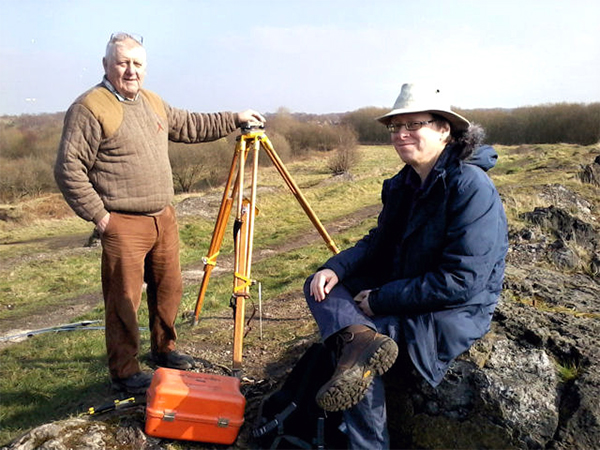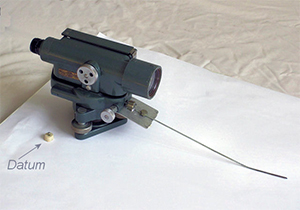
On a glorious day last month, our intrepid field team ventured out to the Kirkless site, in order to complete the surveying we had started last year. (Newsletter No. 163). We had had difficulty indentifying our targets using our newly acquired alidade and plane table. This was because the site is so big and the resulting survey was not a accurate as we would have liked. This time, however, we had two new devices to play with - a theodolite (obtained by Neil from e-Bay) and a modified dumpy level. Dumpies are not normally suitable for this type of work as there is no provision for accurate recording of angular positions. However by attaching a pointer to the front, the dumpy can be used in a similar way to the alidade on the plane table. A plastic plug is used to locate it at the datum point on the table and accurate positions are recoded by swivelling it around this point. Using both devices at each of our two stations we were able to obtain duplicate results which we could then compare for accuracy. As you can see from the results (pto) they matched very well (purple line are plane table, blue theodolite). I have now been able to revise the overlay drawing and am now confident of its accuracy. I can now produce a reverse surveying map which we can use to pinpoint the location of the Iron and Steel Works (shown in green). For the first time we will be able to say for certain what all the humps and bumps and bits of walls in the landscape are. With this information we can produce a project plan with locations for possible excavation to expose the foundations of the Steel Works. complete the surveying we had started last year. (Newsletter No. 163). We had had difficulty indentifying our targets using our newly acquired alidade and plane table. This was because the site is so big and the resulting survey was not a accurate as we would have liked. This time, however, we had two new devices to play with - a theodolite (obtained by Neil from e-Bay) and a modified dumpy level. Dumpies are not normally suitable for this type of work as there is no provision for accurate recording of angular positions. However by attaching a pointer to the front, the dumpy can be used in a similar way to the alidade on the plane table. A plastic plug is used to locate it at the datum point on the table and accurate positions are recoded by swivelling it around this point. Using both devices at each of our two stations we were able to obtain duplicate results which we could then compare for accuracy. As you can see from the results (pto) they matched very well (purple line are plane table, blue theodolite). I have now been able to revise the overlay drawing and am now confident of its accuracy. I can now produce a reverse surveying map which we can use to pinpoint the location of the Iron and Steel Works (shown in green). For the first time we will be able to say for certain what all the humps and bumps and bits of walls in the landscape are. With this information we can produce a project plan with locations for possible excavation to expose the foundations of the Steel Works.
King Arthur's Court
Many places in Britain have been identified with this mythical palace. However in a recent book written by Graham Rob entitled Ancient Paths, the location is squarely set in Standish - specifically at the end of a cul-desac running off Old Pepper Lane. Strange you may think, but the local residences are certainly taking it serious (as they attempt to ward off the possibility of 500 homes being built on this site). Many historians have been sceptical of the Arthurian legend. However this isn't the first time the Wigan area has been linked to this enigmatic leader. A book by C. Hardwick called 'Ancient Battlefields of Lancashire' published in 1882 quotes the Reverend Whitaker writing a hundred years earlier. Whitaker tries to prove that Arthur fought some of his battles in the Wigan area. He points to the fact that the Anglo-Saxon chronicler, Nenius, does actually say that the 2nd, 3rd, 4th and 5th of Arthur's battles were fought on the banks of the Douglas. Here is the the relevant passage from Hardwick's book:
The defeated Saxons appear to have crossed the hill at Wigan, where another engagement took place. In forming the canal there about 1735, the workmen discovered evident indications of a considerable battle on the ground. All along the course of the channel, from the termination of the dock to the point at Poolbridge from 40 to 50 roods in length and 7 to 8 yards in breadth, they found the ground everywhere containing the remains of men and horses, and 5 to 6 cwts, of horse shoes were collected.
The reference to the canal is misleading as the canal into Wigan was only completed in 1814. The river Douglas, however, was being canalised at about the time of Whitaker's report and it is likely that it was this work (probably the construction of the Wigan basin terminus) that is being referred to.
Next Meeting
Wednesday 2nd April - in the Standish Suite at the Brocket Arms (7.30pm as usual). This month we have Sam Rowe who is the Community Archaeology Project Officer for the National Museums Liverpool. He will be telling us about his Rainford Roots project. Over the last few years volunteers have been working with the Merseyside Archaeological Society and National Museums Liverpool on researching and excavating garden sites in Rainford village. Recent investigations have uncovered post medieval industrial material associated with the manufacture of clay tobacco pipes and pottery in the village from the 16th century onwards. Finds have included pottery from 16th-20th century in date, 17th century clay tobacco pipe bowls stamped with maker's marks, locally produced bricks and tiles, and local glass. You can find out more about the project on the website: http://www.rainfordsroots.com/projects.html
It will be very interesting to see and hear about the finds from this project as it resonates quite closely with our own Wigan Hall project. Hope to see you there, BA
|



